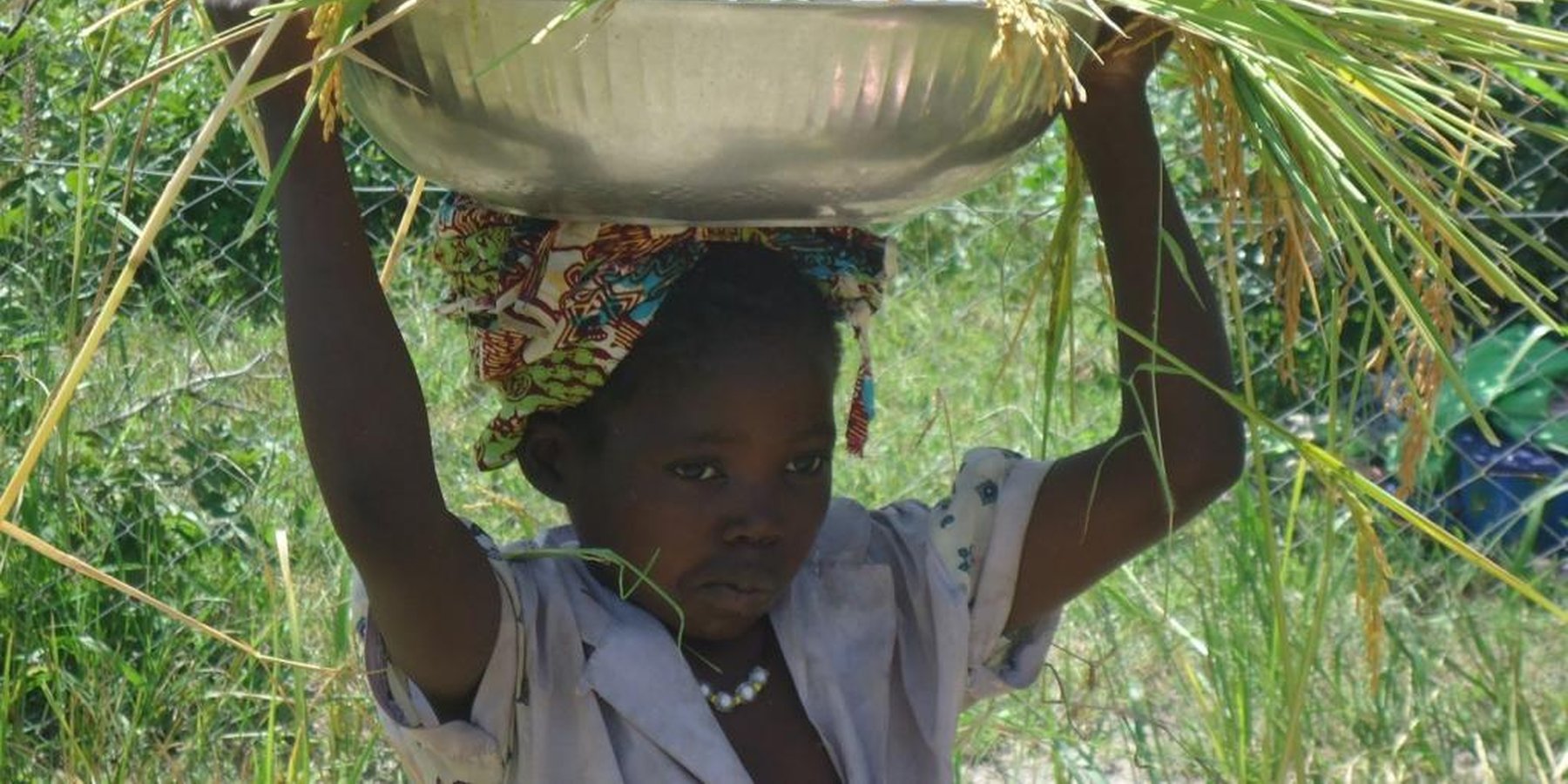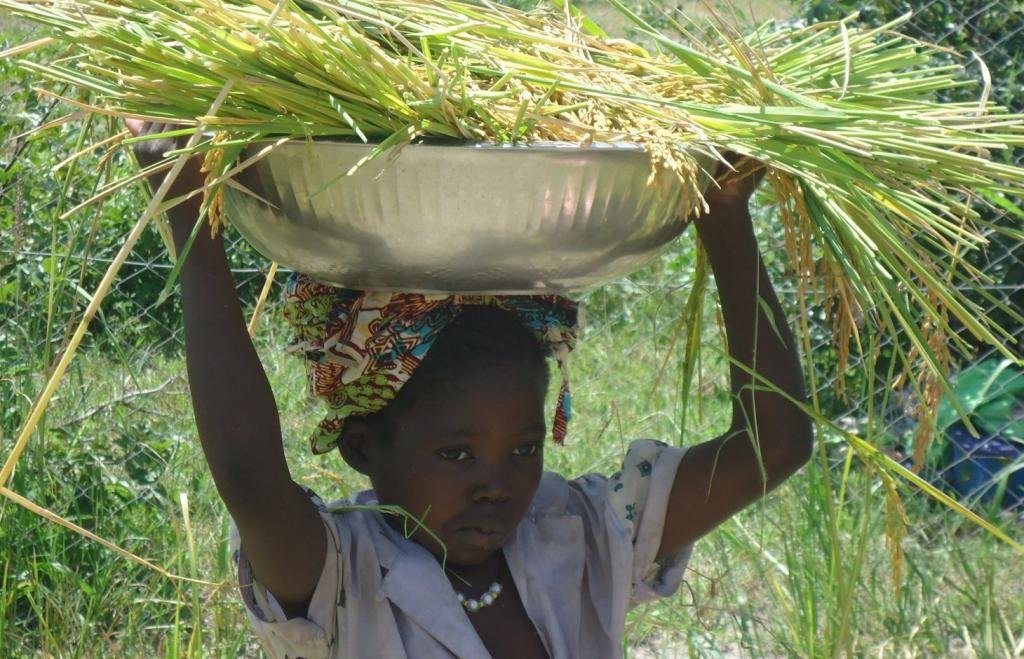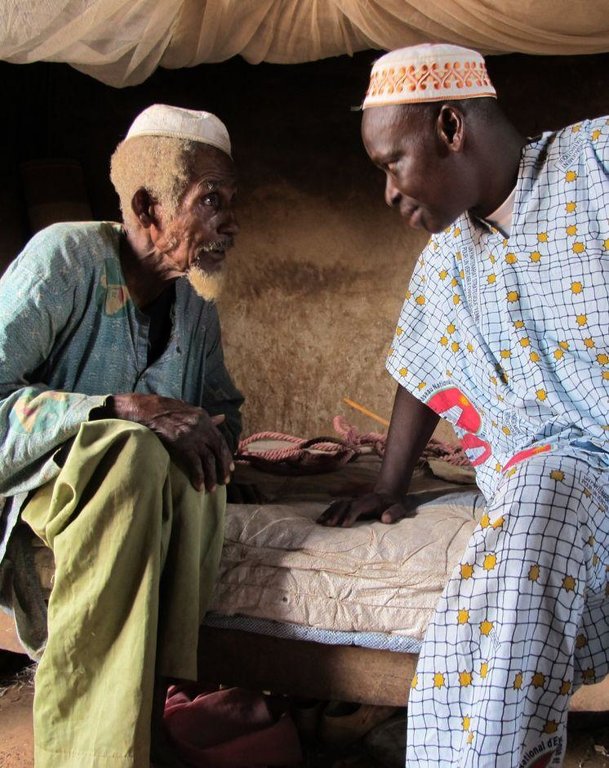Agricultural credit and start-up funding for small-scale irrigation cooperatives [ມາລິ]
- ການສ້າງ:
- ປັບປູງ:
- ຜູ້ສັງລວມຂໍ້ມູນ: Dieter Nill
- ບັນນາທິການ: –
- ຜູ້ທົບທວນຄືນ: Laura Ebneter
Crédit agricole et fonds de démarrage pour les coopératives dans l’irrigation de proximité
approaches_2508 - ມາລິ
ເບິ່ງພາກສ່ວນ
ຂະຫຍາຍທັງໝົດ ຍຸບທັງໝົດ1. ຂໍ້ມູນທົ່ວໄປ
1.2 ລາຍລະອຽດ ການຕິດຕໍ່ ຂອງບຸກຄົນທີ່ຊັບພະຍາກອນ ແລະ ສະຖາບັນ ການມີສ່ວນຮ່ວມ ໃນການປະເມີນຜົນ ແລະ ເອກະສານ ຂອງວິທີທາງ
ຜູ້ຊ່ຽວຊານ ດ້ານການຄຸ້ມຄອງ ທີ່ດິນແບບຍືນຍົງ:
Dembele Célestin
celestin.dembele@helvetas.org
HELVETAS - Swiss Intercooperation
ມາລິ
ຜູ້ຊ່ຽວຊານ ດ້ານການຄຸ້ມຄອງ ທີ່ດິນແບບຍືນຍົງ:
Doumbia Moussa
mtdoumbia@yahoo.fr
Association for the Development and Protection of the Environment (ADEPE Mali)
ມາລິ
Tamini Jacques
jacques.tamini@helvetas.org
HELVETAS - Swiss Intercooperation
ມາລິ
ຊື່ຂອງ ສະຖາບັນການຈັດຕັ້ງ ທີ່ອໍານວຍຄວາມສະດວກ ໃນການສ້າງເອກກະສານ ຫຼື ປະເມີນແນວທາງ (ຖ້າກ່ຽວຂ້ອງ)
Deutsche Gesellschaft für Internationale Zusammenarbeit (GIZ) - ເຢຍລະມັນຊື່ຂອງ ສະຖາບັນການຈັດຕັ້ງ ທີ່ອໍານວຍຄວາມສະດວກ ໃນການສ້າງເອກກະສານ ຫຼື ປະເມີນແນວທາງ (ຖ້າກ່ຽວຂ້ອງ)
HELVETAS (Swiss Intercooperation)1.3 ເງື່ອນໄຂ ຂອງການນໍາໃຊ້ເອກກະສານຂໍ້ມູນ ຂອງ WOCAT
ເມື່ອໃດທີ່ໄດ້ສັງລວມຂໍ້ມູນ (ຢູ່ພາກສະໜາມ)?
01/07/2012
ຜູ້ສັງລວມ ແລະ ບັນດາຜູ້ຕອບແບບສອບຖາມ ຍອມຮັບໃນເງື່ອນໄຂ ການນໍາໃຊ້ຂໍ້ມູນເອກະສານ ທີ່ສ້າງຂື້ນ ໂດຍຜ່ານ ອົງການ WOCAT:
ແມ່ນ
2. ພັນລະນາ ແນວທາງການຄຸ້ມຄອງນໍາໃຊ້ດິນແບບຍືນຍົງ
2.1 ການອະທິບາຍ ໂດຍຫຍໍ້ ຂອງວິທີທາງ
Providing lowland farmer cooperatives with self-managed, self-renewing financial resources for the purpose of facilitating members’ access to farming inputs.
2.2 ການອະທິບາຍ ລາຍລະອຽດ ຂອງວິທີທາງ
ການອະທິບາຍ ລາຍລະອຽດ ຂອງວິທີທາງ:
Once the infrastructure has been put in place, cooperatives are supported in drawing up their cropping plans (rice and vegetable growing). This support is provided in the context of value enhancement. The cropping plans include forecasting in relation to sites and the input needs of member farmers. The funds provided by the project are targeted towards supporting the empowerment of cooperatives and constitute non-repayable grants. Cooperatives use these financial resources to provide their members with loans to grow crops. When these crops are sold, the loans are repaid to the cooperatives along with a small percentage of interest to renew the loan facility. The loan awarding system, interest rates and repayment deadline are clearly defined by the cooperative. Women have access to gender-specific mechanisms, such as a facility to access credit without providing any personal contribution. The grant is awarded following a capacity-building process focusing on the management and governance of the cooperative. Following negotiations, the programme funds the cooperative’s cropping plan on the basis of a collaboration agreement. Support with managing the funds is delivered by a consultant. The grant is paid into the cooperative’s bank account. The cooperative organises the procurement of inputs, in collaboration with the service provider. Loans are provided in kind (seed, fertilisers, pesticides, etc.) rather than as cash. Those tasked with managing the cooperative are given training in how to use a range of management tools (drawing up cropping plans; keeping stock inventory, loan and repayment records; managing removal and delivery receipts; etc.). At the end of the growing season, the loans are repaid in kind (seed) and in cash (fertilisers and fungicides) in accordance with a predetermined timetable, thus replenishing the fund.
The structuring, organisational strengthening and management capacity building activities are delivered by the consultant from the outset of the scheme’s implementation phase. Groups of actors are encouraged to organise themselves as cooperatives (women and men rice growers, vegetable and other kinds of growers, etc.). These cooperatives, with the support of the consultancies, act as the representative for managing funds. They draw up their cropping plans (list of member producers and their farmland, and evaluation of the input requirements requested by producers) and define the system for awarding loans (the access conditions, repayment methods, timetables and interest levels are set by the cooperatives). An agreement setting out the ways in which the programme will provide support through a contracted service provider is signed. Funds are paid into the relevant bank account and the cooperative then procures the inputs. The cooperative managers, using the management tools at their disposal, distribute the inputs to producers. A public audit is organised to inform members about the status of loans. The recovery of loans with interest makes it possible to replenish the fund (with payments paid into the cooperative’s bank account). The public audit into the loan repayment situation is a medium for deploying coercive measures to recover unpaid loans.
The cooperatives catalogue needs, coordinate the preparation of the cropping plan, set the access conditions for loans, undertake procurement and ensure the recovery of loans from members. The communes participate in debriefings, facilitate the settlement of misunderstandings between producers and cooperatives, and monitor technical support provision. The intermunicipal body facilitates communication and negotiation between communes and the programme. Consultancies deliver management training and advisory support on technical aspects of farming, and facilitate the procurement of inputs suited to the farming condition of each site. Technical services participate in evaluation meetings and act as advisors to the service providers and programme team.
2.3 ຮູບພາບຂອງແນວທາງ
2.5 ປະເທດ / ເຂດ / ສະຖານທີ່ບ່ອນທີ່ແນວທາງໄດ້ຖືກນໍາໃຊ້
ປະເທດ:
ມາລິ
ພາກພື້ນ / ລັດ / ແຂວງ:
Mali
ຂໍ້ມູນເພີ່ມເຕີມຂອງສະຖານທີ່:
Bougouni, Kolondiéba, Yanfolila
2.6 ວັນທີເລີ່ມຕົ້ນ ແລະ ສິ້ນສຸດ ການຈັດຕັ້ງປະຕີບັດ ວິທີທາງ
ສະແດງປີຂອງການເລີ່ມຕົ້ນ:
2008
2.7 ປະເພດຂອງແນວທາງ
- ພາຍໃຕ້ໂຄງການ / ແຜນງານ
2.8 ເປົ້າໝາຍ / ຈຸດປະສົງຫຼັກ ຂອງການຈັດຕັ້ງປະຕິບັດ ວິທີທາງ
Providing lowland farmer cooperatives with self-managed, self-renewing financial resources for the purpose of facilitating members’ access to farming inputs.
The SLM Approach addressed the following problems: lack of cash to invest in SLM
2.9 ເງື່ອນໄຂອໍານວຍ ຫຼື ຂັດຂວາງການປະຕິບັດຂອງເຕັກໂນໂລຢີ / ເຕັກໂນໂລຢີການນໍາໃຊ້ຕາມແນວທາງ
ມີຄວາມສາມາດ / ເຂັ້າເຖິງຊັບພະຍາກອນດ້ານການເງິນ ແລະ ການບໍລິການ
- ເຊື່ອງຊ້ອນ
lack of cash to invest in SLM
Treatment through the SLM Approach: Providing lowland farmer cooperatives with self-managed, self-renewing financial resources for the purpose of facilitating members’ access to farming inputs.
3. ການມີສ່ວນຮ່ວມ ແລະ ບົດບາດຂອງພາກສ່ວນທີ່ກ່ຽວຂ້ອງທີ່ໄດ້ມີສ່ວນຮ່ວມ
3.1 ຜູ້ມີສ່ວນຮ່ວມ ໃນວິທີທາງ ແລະ ພາລະບົດບາດ ຂອງເຂົາເຈົ້າ
- ຜູ້ນໍາໃຊ້ດິນໃນທ້ອງຖິ່ນ / ຊຸມຊົນທ້ອງຖິ່ນ
- ຜູ້ຊ່ຽວຊານ ການນຄຸ້ມຄອງ ທີ່ດິນແບບຍືນຍົງ / ທີ່ປຶກສາດ້ານກະສິກໍາ
- ອົງການຈັດຕັ້ງ ທີ່ບໍ່ຂື້ນກັບລັດຖະບານ
- ອໍານາດ ການປົກຄອງທ້ອງຖິ່ນ
- ພະນັກງານຂັ້ນສູນກາງ (ຜູ້ວາງແຜນ, ຜູ້ສ້າງນະໂຍບາຍ)
3.2 ການມີສ່ວນຮ່ວມຂອງຜູ້ນໍາໃຊ້ທີ່ດິນໃນທ້ອງຖິ່ນ / ຊຸມຊົນທ້ອງຖິ່ນໃນໄລຍະທີ່ແຕກຕ່າງກັນຂອງແນວທາງ
| ການລວບລວມ ເອົາຜູ້ນໍາໃຊ້ດິນ ໃນທ້ອງຖິ່ນ / ຊຸມຊົນທ້ອງຖິ່ນ | ໃຫ້ລະບຸ ຜູ້ໃດທີ່ມີສ່ວນຮ່ວມ ໃນແຕ່ລະກິດຈະກໍາ? | |
|---|---|---|
| ການເລີ່ມຕົ້ນ / ແຮງຈູງໃຈ | ການບໍ່ປະຕິບັດ | |
| ການວາງແຜນ | ການຮ່ວມມື | |
| ການປະຕິບັດ | ການຮ່ວມມື | |
| ຕິດຕາມກວດກາ / ການປະເມີນຜົນ | ການຮ່ວມມື | |
| Research | ການບໍ່ປະຕິບັດ |
3.4 ການຕັດສິນໃຈກ່ຽວກັບການຄັດເລືອກເຕັກໂນໂລຢີຂອງການຄຸ້ມຄອງທີ່ດິນແບບຍືນຍົງ / ເຕັກໂນໂລຢີ
ລະບຸ ຄົນທີ່ຕັດສິນໃຈ ກ່ຽວກັບການຄັດເລືອກຂອງ ເຕັກໂນໂລຢີ / ເຕັກໂນໂລຢີ ຈະໄດ້ຮັບການປະຕິບັດ:
- ຜູ້ນໍາໃຊ້ທີ່ດິນຫຼັກ, ການສະໜັບສະໜູນ ໂດຍຜູ້ຊ່ຽວຊານ ການນໍາໃຊ້ທີ່ດິນແບບຍືນຍົງ
ອະທິບາຍ:
Decisions on the method of implementing the SLM Technology were made by mainly by land users supported by SLM specialists
4. ການສະໜັບສະໜູນທາງດ້ານວິຊາການ, ການສ້າງຄວາມສາມາດ, ແລະ ການຈັດການຄວາມຮູ້.
4.1 ການສ້າງຄວາມສາມາດ / ການຝຶກອົບຮົມ
ຜູ້ນໍາໃຊ້ທີ່ດິນ ຫຼື ພາກສ່ວນກ່ຽວຂ້ອງອື່ນໆ ໄດ້ຮັບການຝຶກອົບຮົມບໍ່?
ແມ່ນ
ໃຫ້ລະບຸ ຜູ້ໃດທີ່ໄດ້ຮັບການຝຶກອົບຮົມ:
- ຜູ້ນໍາໃຊ້ດິນ
- ພະນັກງານພາກສະໜາມ / ທີ່ປຶກສາ
ຮູບແບບຂອງການຝຶກອົບຮົມ:
- ກອງປະຊຸມ
- ຫຼັກສູດ
ໃນຫົວຂໍ້:
Consultancies deliver management training and advisory support on technical aspects of farming. Those tasked with managing the cooperative are given training in how to use a range of management tools (drawing up cropping plans; keeping stock inventory, loan and repayment records; managing removal and delivery receipts; etc.).
4.2 ການບໍລິການໃຫ້ຄໍາປຶກສາ
ເຮັດຜູ້ໃຊ້ທີ່ດິນມີການເຂົ້າເຖິງການບໍລິການໃຫ້ຄໍາປຶກສາ?
ແມ່ນ
ລະບຸວ່າການສະໜອງ ການບໍລິການ ໃຫ້ຄໍາປຶກສາ:
- ໃນພື້ນທີ່ຂອງຜູ້ນໍາໃຊ້ດິນ
ອະທິບາຍ / ຄວາມຄິດເຫັນ:
Name of method used for advisory service: Providing lowland farmer cooperatives with self-managed, self-renewing financial resources ; A local farming advisory mechanism active in the first few years of the scheme ensures high levels of productivity, which, in turn, facilitates the repayment of loans. Holding public audits to report on accounts ensures that the system is transparent.
Advisory service is quite adequate to ensure the continuation of land conservation activities
4.3 ສະຖາບັນການສ້າງຄວາມເຂັ້ມແຂງ (ການພັດທະນາອົງການຈັດຕັ້ງ)
ສະຖາບັນ ໄດ້ຮັບການສ້າງຕັ້ງຂື້ນ ຫຼື ໄດ້ຮັບການສ້າງຄວາມເຂັ້ມແຂງ ໂດຍການຈັດຕັ້ງປະຕິບັດ ວິທີທາງບໍ່?
- ມີ, ພໍສົມຄວນ
ລະບຸ ທາງສະຖາບັນ ໄດ້ສ້າງຄວາມເຂັ້ມແຂງ ໃນລະດັບໃດ (ຫຼາຍ):
- ທ້ອງຖິ່ນ
ລະບຸ ປະເພດ ຂອງສະໜັບສະໜູນ:
- ທາງດ້ານການເງິນ
- ການສ້າງຄວາມອາດສາມາດ / ການຝຶກອົບຮົມ
4.4 ຕິດຕາມກວດກາ ແລະ ປະເມີນຜົນ
ການຈັດຕັ້ງປະຕິບັດ ວິທີທາງ ໄດ້ມີການປະເມີນຜົນ ແລະ ຕິດຕາມບໍ?
ແມ່ນ
ຄວາມຄິດເຫັນ:
socio-cultural aspects were ad hoc monitored by project staff through observations
economic / production aspects were ad hoc monitored by project staff, land users through measurements
management of Approach aspects were ad hoc monitored by project staff, land users through observations
There were no changes in the Approach as a result of monitoring and evaluation: None
There were no changes in the Technology as a result of monitoring and evaluation: None
4.5 ການຄົ້ນຄວ້າ
ນີ້້ແມ່ນສ່ວນໜຶ່ງ ການຄົ້ນຄວ້າ ຂອງວິທີທາງບໍ່?
ແມ່ນ
ລະບຸ ຫົວຂໍ້:
- ສັງຄົມ
- ເສດຖະສາດ / ການຕະຫຼາດ
- ລະບົບນິເວດ
- ເຕັກໂນໂລຢີ
5. ການສະໜັບສະໜູນທາງດ້ານການເງິນ ແລະ ອຸປະກອນຈາກພາຍນອກ
5.1 ງົບປະມານປະຈໍາປີ ສໍາລັບວິທີທາງ ຂອງການຄຸ້ມຄອງ ທີ່ດິນແບບຍືນຍົງ
ຄໍາເຫັນ (ຕົວຢ່າງ: ແຫຼ່ງຂໍ້ມູນຫຼັກ ຂອງການສະໜອງທຶນ / ຜູ້ໃຫ້ທຶນທີ່ສໍາຄັນ):
Approach costs were met by the following donors: international non-government: 100.0%
5.2 ການສະໜັບສະໜູນ ທາງດ້ານການເງິນ / ອຸປະກອນ ສະໜອງໃຫ້ແກ່ຜູ້ນໍາທີ່ດິນ
ຜູ້ນໍາໃຊ້ດິນ ໄດ້ຮັບການສະໜັບສະໜູນ ທາງດ້ານ ການເງິນ / ອຸປະກອນ ໃນການຈັດຕັ້ງປະຕິບັດ ເຕັກໂນໂລຢີບໍ?
ແມ່ນ
ຖ້າແມ່ນ, ໃຫ້ລະບຸປະເພດ (ຫຼາຍ) ຂອງການສະໜັບສະໜູນ, ເງື່ອນໄຂ ແລະ ຜູູ້ສະໜອງ (ຫຼາຍ):
The funds provided by the project are targeted towards supporting the empowerment of cooperatives and constitute non-repayable grants. Cooperatives use these financial resources to provide their members with loans to grow crops. When these crops are sold, the loans are repaid to the cooperatives along with a small percentage of interest to renew the loan facility. The loan awarding system, interest rates and repayment deadline are clearly defined by the cooperative. Women have access to gender-specific mechanisms, such as a facility to access credit without providing any personal contribution.
5.3 ເງິນສົມທົບສໍາລັບການນໍາໃຊ້ສະເພາະປັດໃຈຂາເຂົ້າໃນການຜະລີດກະສິກໍາ (ລວມທັງແຮງງານ)
ຖ້າແຮງງານ ຂອງຜູ້ນໍາໃຊ້ດິນ ໄດ້ຮັບການສະໜັບສະໜູນ ປັດໃຈຂາເຂົ້າ, ແມ່ນບໍ່:
- ໄດ້ຮັບການສະໜັບສະໜູນ ອຸປະກອນດ້ານອື່ນ
ຄວາມຄິດເຫັນ:
Loans are provided in kind (seed, fertilisers, pesticides, etc.) rather than as cash.
5.4 ສິນເຊື່ອ
ໄດ້ປ່ອຍສິນເຊື່ອ ສະໜອງໃຫ້ພາຍໃຕ້ ວິທີການສໍາລັບກິດຈະກໍາ ການຄຸ້ມຄອງ ທີ່ດິນແບບຍືນນຍົງບໍ່?
ແມ່ນ
ເງື່ອນໄຂກໍານົດ (ອັດຕາດອກເບ້ຍ, ຈ່າຍຄືນ, ແລະ ອື່ນໆ) :
repayment conditions: The funds provided by the project are used to buy inputs on the basis of the cropping plan. The start-up fund granted by the programme pays for the initial stock. Once this stock has been procured, the inputs are distributed to members according to their stated requirements. The repayment schedule and the amount of interest that must be paid are communicated. Growers’ production activities are supported and monitored by the consultant and the management committee. Following the harvesting and sale of crops, in accordance with the deadline set, the loans are recovered along with their interest payments and the fund is replenished for the following growing season. During the different implementation stages, the cooperative holds public audits in the presence of the commune authorities to report on how the cooperative is being managed; the aim being to build trust between the cooperative and its members.
6. ວິເຄາະຜົນກະທົບ ແລະ ສັງລວມບັນຫາ
6.1 ຜົນກະທົບຂອງແນວທາງ
ການຈັດຕັ້ງປະຕິບັດ ວິທີທາງ ສາມາດຊ່ວຍຜູ້ນໍາໃຊ້ທີ່ດິນ ໃນການຈັດຕັ້ງປະຕິບັດ ແລະ ບໍາລຸງຮັກສາ ເຕັກໂນໂລຢີ ການຄຸ້ມຄອງ ທີ່ດິນແບບຍືນຍົງໄດ້ບໍ?
- ບໍ່
- ມີ, ໜ້ອຍໜຶ່ງ
- ມີ, ພໍສົມຄວນ
- ມີ, ຫຼາຍ
A local farming advisory mechanism active in the first few years of the scheme ensures high levels of productivity
ການຈັດຕັ້ງປະຕິບັດ ວິທີທາງ ສາມາດສ້າງຄວາມເຂັ້ມແຂງ ທາງສັງຄົມ ແລະ ເສດຖະກິດບໍ່?
- ບໍ່
- ມີ, ໜ້ອຍໜຶ່ງ
- ມີ, ພໍສົມຄວນ
- ມີ, ຫຼາຍ
Did other land users / projects adopt the Approach?
- ບໍ່
- ມີ, ໜ້ອຍໜຶ່ງ
- ມີ, ພໍສົມຄວນ
- ມີ, ຫຼາຍ
The system has been applied in 19 sites across 15 communes in the circles of Bougouni, Kolondiéba and Yanfolila. In total, 2,150 producers – 81% of the farmers identified in the production areas – have benefited from the loan scheme. The approach has been in use since 2008.
Did the Approach lead to improved livelihoods / human well-being?
- ບໍ່
- ມີ, ໜ້ອຍໜຶ່ງ
- ມີ, ພໍສົມຄວນ
- ມີ, ຫຼາຍ
Groups of actors are encouraged to organise themselves as cooperatives (women and men rice growers, vegetable and other kinds of growers, etc.). In total, 2,150 producers – 81% of the farmers identified in the production areas – have benefited from the loan scheme.
Did the Approach help to alleviate poverty?
- ບໍ່
- ມີ, ໜ້ອຍໜຶ່ງ
- ມີ, ພໍສົມຄວນ
- ມີ, ຫຼາຍ
70% of the beneficiaries have improved their production levels. This management experience enables farmers to operate as entrepreneurs and to accurately assess their profitability
6.2 ແຮງຈູງໃຈຫຼັກຂອງຜູ້ນໍາໃຊ້ທີ່ດິນໃນການປະຕິບັດການຄຸ້ມຄອງທີ່ດິນແບບຍືນຍົງ
- ການຜະລິດເພີ່ມຂຶ້ນ
- ການຊໍາລະເງິນ / ເງິນອຸດໜູນ
6.3 ຄວາມຍືນຍົງຂອງກິດຈະກໍາວິທີທາງ
ຜູ້ນໍາໃຊ້ ທີ່ດິນ ສາມາດສືບຕໍ່ ການຈັດຕັ້ງປະຕິບັດ ຜ່ານວິທີທາງໄດ້ບໍ່ (ໂດຍປາດສະຈາກ ການຊ່ວຍເຫຼືອ ຈາກພາກສ່ວນພາຍນອກ)?
- ແມ່ນ
6.4 ຈຸດແຂງ / ຂໍ້ດີ ຂອງວິທີທາງ
| ຈຸດແຂງ / ຈຸດດີ / ໂອກາດ ຈາກທັດສະນະຂອງຜູ້ປ້ອນຂໍ້ມູນ ຫຼື ບຸກຄົນສຳຄັນ |
|---|
| Cooperatives are empowered to manage the funds. (How to sustain/ enhance this strength: It must be clearly communicated that the funds belong to the cooperative and are only granted once. The granting of in-kind (inputs) rather than cash loans curbs any attempts to stray from the objectives. ) |
| Since the programme began in 2008, the cooperatives have managed to achieve recovery rates of between 80% and 100%, and, with the system in place, 70% of the beneficiaries have improved their production levels. This management experience enables farmers to operate as entrepreneurs and to accurately assess their profitability. (How to sustain/ enhance this strength: Institutional and organisational strengthening plays a key role in achieving a successful outcome. ) |
| Following the granting of an initial ‘seed fund’, the financing mechanism grows and becomes sustainable on its own. |
| Evaluation meetings bring together actors from all the sites (commune authorities, cooperatives), consultancies and the programme team, serving to motivate actors and offering the opportunity to share experiences. |
| A local farming advisory mechanism active in the first few years of the scheme ensures high levels of productivity, which, in turn, facilitates the repayment of loans. Holding public audits to report on accounts ensures that the system is transparent. |
7. ເອກກະສານອ້າງອີງ ແລະ ຂໍ້ມູນການເຊື່ອມໂຍງ
7.1 ວິທີການ / ແຫຼ່ງຂໍ້ມູນ
- ການໄປຢ້ຽມຢາມພາກສະໜາມ, ການສໍາຫຼວດພາກສະໜາມ
- ການສໍາພາດ ຜູ້ນໍາໃຊ້ທີ່ດິນ
7.2 ເອກະສານທົ່ວໄປທີ່ສາມາດໃຊ້ໄດ້
ຫົວຂໍ້, ຜູ້ຂຽນ, ປີ, ISBN:
Manual of Good Practices in Small Scale Irrigation in the Sahel. Experiences from Mali. Published by GIZ in 2014.
ມີຢູ່ໃສ?ມູນຄ່າເທົ່າໃດ?
http://star-www.giz.de/starweb/giz/pub/servlet.starweb
ຫົວຂໍ້, ຜູ້ຂຽນ, ປີ, ISBN:
2011 report: Accompagnement à la valorisation des ouvrages hydro-agricoles sur les sites de Blakala, Ména, Bafaga, Mamissa, Bogodougou, Nèrèkoro, Koloni et Mogoyafara [Support to enhance the value of hydro-agricultural schemes in Blakala, Ména, Bafaga, Mamissa, Bogodougou, Nèrèkoro, Koloni and Mogoyafara] (GSAD – Sahelian Development Support Group)
ຫົວຂໍ້, ຜູ້ຂຽນ, ປີ, ISBN:
2011 report: Accompagnement à la valorisation des ouvrages hydro-agricoles sur les sites de Niakobougou, Blendougou, N’Gala, Banko, Faradiélé, Sibirila, Solona, Farababougou [Support to enhance the value of hydro-agricultural schemes in Niakobougou, Blendougou, N’Gala, Banko, Faradiélé, Sibirila, Solona and Farababougou] (BEACIL – Consultancy and Advisory Support for Local Initiatives)
ຫົວຂໍ້, ຜູ້ຂຽນ, ປີ, ISBN:
2013 report: Collecte de données sur la valorisation des ouvrages hydro-agricoles réalisés dans le Pôle de Bougouni sur le financement
ຂໍ້ມູນການເຊື່ອມຕໍ່ ແລະ ເນື້ອໃນ
ຂະຫຍາຍທັງໝົດ ຍຸບທັງໝົດການເຊື່ອມຕໍ່
ບໍ່ມີຂໍ້ມູນການເຊື່ອມຕໍ່
ເນື້ອໃນ
ບໍ່ມີເນື້ອໃນ




